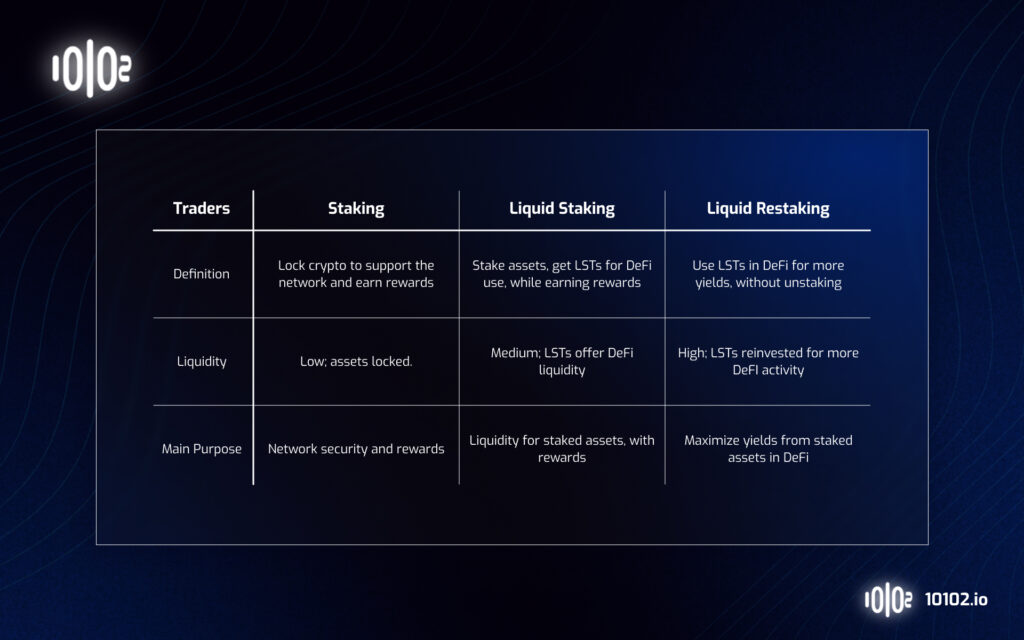Overview
Restaking allows Ethereum validators to opt in to providing cryptoeconomic security to multiple protocols simultaneously in return for earning additional rewards.
The concept of restaking was introduced by EigenLayer, and it expands the concept of staking by allowing staked ETH to be reused to secure additional protocols. This enables other projects to leverage Ethereum’s security, as they can tap into Ethereum’s validators instead of needing to bootstrap their own network of stakers.
For example, consider a decentralized blockchain bridge that facilitates asset transfers between two networks. A common way to design decentralized bridges is to have a group of operators manage the bridge and verify transactions. However, to avoid corruption, these operators typically must lock up their tokens as collateral to ensure they act honestly.
The problem is that a new bridge may struggle to attract enough capital to make attacks prohibitively expensive. Even mature bridges might only have $100 million worth of assets staked as security. If an attacker can gather more than that amount, they could potentially take over the bridge and approve fraudulent transactions.
At its core, EigenLayer creates a marketplace between:
- Restakers: Users who have staked ETH or LSTs and seek additional yield.
- Projects (AVSs): Protocols that require cryptoeconomic security and are willing to offer rewards in exchange for it. These are known as Actively Validated Services, or AVSs.
If a validator participating in the bridge acts maliciously or fails to fulfill their responsibilities, a portion of their restaked ETH can be slashed. This makes attacks far more expensive, as an attacker would now need to accumulate a significant portion of Ethereum’s staked ETH rather than just surpassing the bridge’s native stake.
By leveraging restaked ETH, the bridge benefits from Ethereum’s robust security model while validators earn additional rewards for extending their security to new protocols. This creates a win-win situation: The bridge gets stronger protection, and validators increase their yield without unstaking their ETH.

Key terms:
- Restaking: The process of reusing staked ETH to provide security for multiple protocols, enabling additional yield while maintaining Ethereum’s cryptoeconomic security.
- Actively Validated Service (AVS): A protocol or application that requires additional security beyond Ethereum’s base layer. AVSs rely on restakers to validate transactions or enforce cryptoeconomic guarantees. (Equivalent concepts exist in other ecosystems, such as Babylon for Bitcoin).
- Restaking Marketplace: An open market where AVSs offer yield to attract security and restakers delegate to validators/operators based on risk vs. reward incentives.
Why Restake?
Instead of forcing new projects to bootstrap their own validator networks (which requires attracting capital and proving long-term sustainability), restaking allows them to tap into Ethereum’s existing stakers. In return, validators who opt into restaking earn an additional yield on top of their standard Ethereum staking rewards.
This creates a win-win scenario:
- For validators: They can earn more yield by securing multiple protocols while still maintaining their role as Ethereum validators.
- For new projects (AVSs): They gain access to Ethereum-grade security without having to create an entirely new staking infrastructure.
That being said, it is overly complex for an average DeFi user to engage in restaking, which is why Liquid Restaking protocols were introduced
Key Considerations
-
- Increased Yield & Higher Slashing Risk: Restakers earn additional rewards by securing multiple AVSs, creating new income streams beyond Ethereum staking rewards. Validators securing multiple AVSs are exposed to more penalties, if an operator is slashed for one service, all restakers delegating to them may suffer losses.
- Smart Contract & Protocol Risk: Restaking and Liquid Restaking protocols rely on complex smart contracts, increasing the attack surface for exploits and governance risks.
- Ethereum Network Stability: If too much ETH is restaked across AVSs, a major slashing event could lead to mass liquidations, impacting Ethereum’s staking and validator ecosystem.
- Restaking introduce new financial opportunities while extending Ethereum’s security model. However, risk management, validator selection, and protocol robustness are essential to maintaining long-term stability and sustainability.
Restaking Key Projects
There are 3 projects worth knowing about in restaking space:
- EigenLayer: The pioneer and largest restaking protocol on Ethereum. Most other projects are built on top of
- Kelp: A liquid restaking protocol built on EigenLayer that issues Liquid Restaking Tokens (LRTs), enabling users to retain liquidity while restaking their assets.
- Ether.Fi: A liquid restaking protocol also built on EigenLayer, with some differences compared to Kelp such as around fees and governance.
One other interesting project worth noting is Babylon, which provides a form of restaking infrastructure for Bitcoin. By locking up BTC on the Bitcoin Network, users can lend security to Proof-of-Stake networks.


